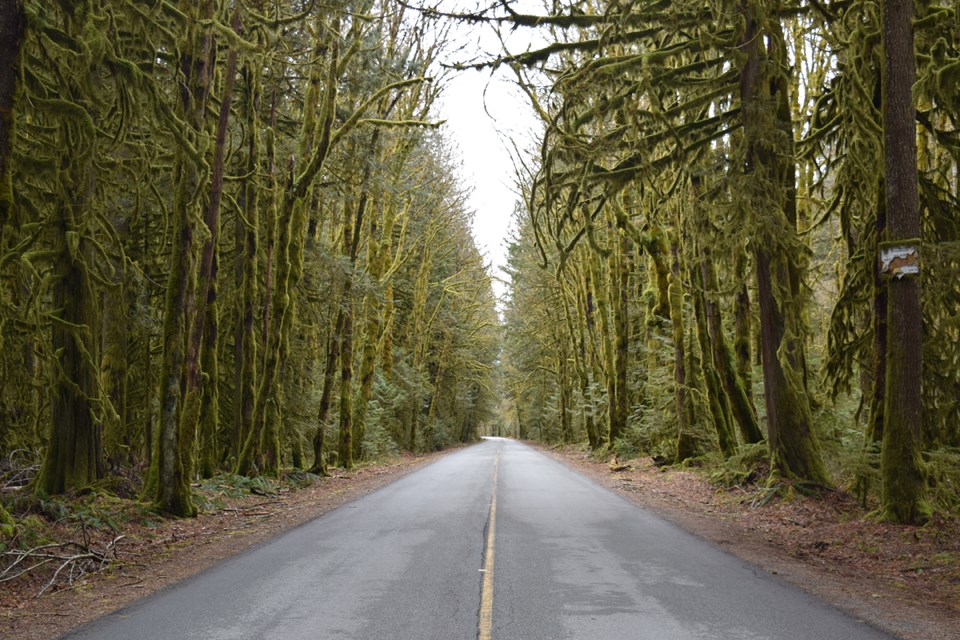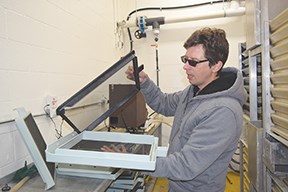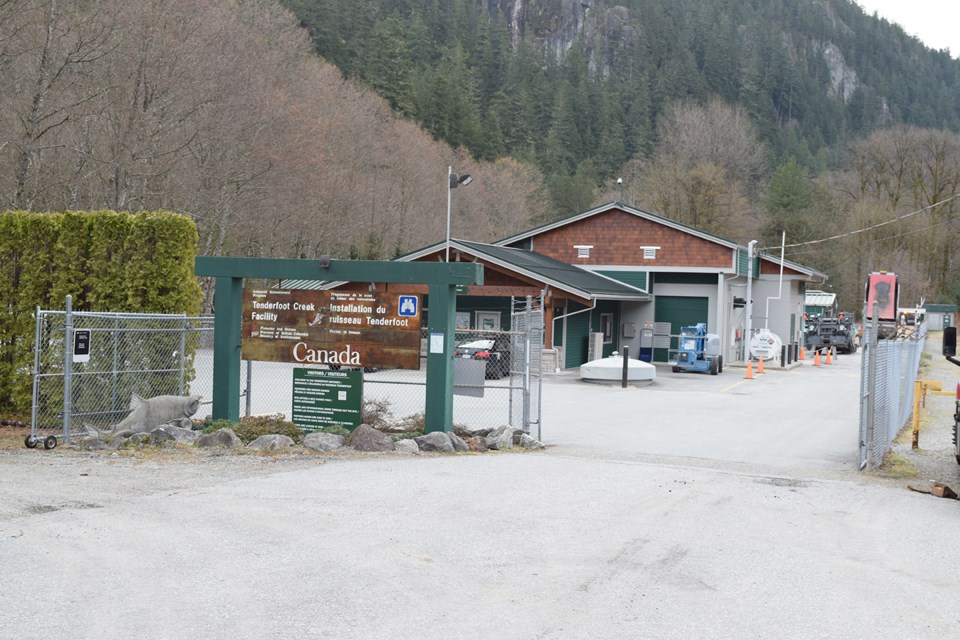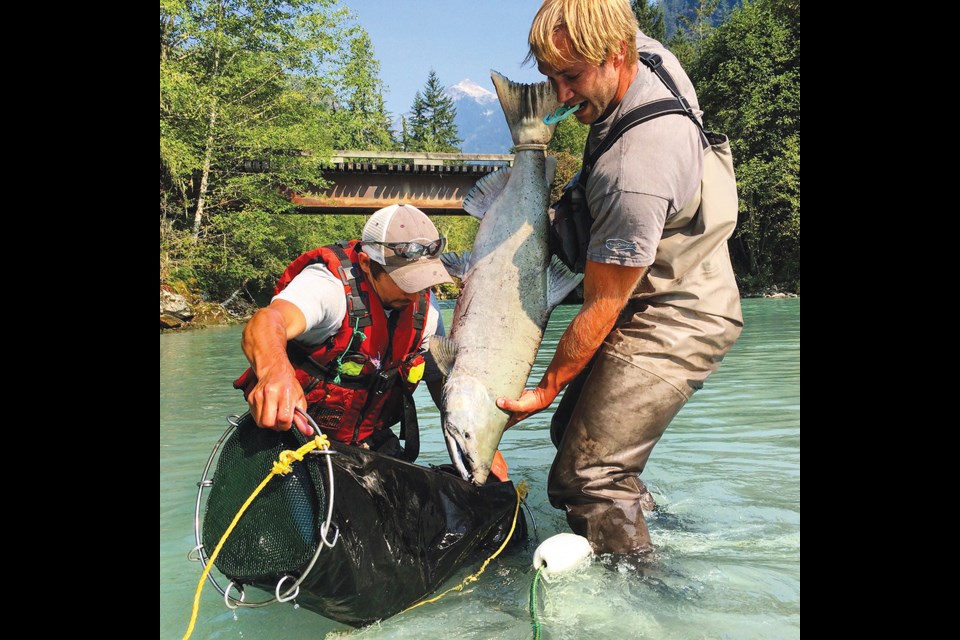
For Squamish families looking to spend an afternoon doing something outdoors that is a little different from the usual dog walking or trail riding, the Tenderfoot Creek Hatchery may be just the thing.
The hatchery is located about 25 minutes by car north of downtown Squamish in Paradise Valley.
Even for locals used to Squamish’s beauty, the drive itself is worth the trip given the breathtaking canopy of trees that welcomes visitors to the area.
The nondescript looking Fisheries and Oceans Canada hatchery, tucked at the end of a rural road, offers self-guided tours through interpretive signage, but Jeremy Smith, the facility’s watershed enhancement manager, told The Chief, staff members are often happy to answer questions or provide visitors with guidance.
Built in 1981, the hatchery exists to improve salmon stocks in the Squamish River watershed.
Depending on the time of year, there’s a variety of salmon to be seen. Adult chinook can be spotted from July to September, adult coho from November to January, adult chum can be seen from October to December in Tenderfoot Lake, which is adjacent to the facility, while coho and chinook juveniles are present year-round on site.
Fall is the best time of year to visit, according to Smith.
“If you want to see a variety, October would be a great time to come,” he said, adding this past fall during spawning season there was a record 26,000 chum in the lake.
Natural spawning can be seen in Tenderfoot Lake, which is an upwelling lake, meaning the water comes up through the rocks.
“You get to see the best of both worlds. You get to see what the government is doing in terms of trying to enhance the stocks up in the Squamish area, but you can also see [the fish] doing their own business as well, which is a huge draw,” he said, though adding in December the area “reeks” because there’s thousands of carcasses in the lake.
After so many years working with fish, Smith said he still usually enjoys eating salmon, but not during spawning season when the smell of the rotting fish pervades.
After smelling rotting fish all day he doesn’t have the stomach to cook salmon once he gets home, he said with a laugh.
Though fish aren’t spawning during the spring and summer there is still plenty to see and learn.
“You can see lots of little fish being fed and moved around,” Smith said.
More than 265,000 chinook were released from Tenderfoot hatchery in 2016, according to Fisheries and Oceans Canada data.
Almost 890,000 chum and 184,000 coho were also released.
The main goal of the hatchery is to supplement the wild salmon population.

“The wild population has taken big hits from agriculture, forestry and other forms of industry in and around Vancouver, including the Squamish area. Definitely urbanization has had a large impact, as well, and the federal government saw the natural populations go into a downward spiral in the 1970s,” Smith explained.
The salmon enhancement program came into being in 1977.
Originally bolstering the commercial catch was the aim, according to Smith, but that has evolved.
Currently the aim is conservation while still supporting recreation, First Nations and commercial fisheries, he said.
The hatchery staff goes out into the field for fish to spawn and eventually the progeny is released back where the parent was taken from.
Visitors to the hatchery can follow the fish progression.
In incubation rooms, thousands of salmon eggs are kept in basket trays. Water travels through the trays and keeps the fish alive.
When they mature to fry they move to the next area of the facility, outdoor rows of trough-like containers. In this area visitors can sometimes see the fry being fed by staff.
To enable the hatchery to gauge how successful the program is, when the fry reach about two grams, likely in the end of May or beginning of June, they receive coded wire tags. Each millimetre-long bar code is injected by hand into the salmon’s nose where it stays for the rest of its life. The fin of the salmon is also clipped.
The anglers in Squamish are well educated and know if they see a clipped salmon it has come from the hatchery, Smith said.
“If they take that salmon home to eat there’s an expectation that they will return the head to the government with a little bit of information: where they caught it, how big the fish was,” he said. The heads are then sent to a lab where the bar code is removed.
Smith said B.C. chinooks have been intercepted in U.S. waters and vice versa.
“At the end of the day, they look at how much each country contributed and it helps determine how much should be spent by each country on things like enhancement and that all feeds into Pacific salmon treaties and all of that,” Smith said.
Smith said he hopes people come away from a visit with increased respect for salmon and a better understanding of how human activities can impact fish.
Most storm drains feed directly into natural waterways, he said.
“All it takes is for somebody to accidentally release some paint or do an oil change and it has a really big impact on those small urban streams.”
Keep dogs and vehicles out of the streambeds when out recreating in and around Squamish, Smith stressed.
“Especially during the spawning season,” he added. “You don’t really want to be disturbing them.”
Smith said salmon are not only intrinsically valuable, but also important because of what they give back to other animals such as bears and eagles and the environment – even after they die.
“One thing I don’t think a lot of people realize is how much nutrients there is in a salmon carcass,” he said.
The coastal temperate rainforest, in general, is nutrient-poor because so much gets washed away with every rainfall, but not in the Squamish watershed, according to Vanessa Isnardy, WildSafeBC community coordinator.
“Trees grow larger and faster along fish-bearing watercourses. Their advantage is a nutrient source from the sea – the Pacific salmon,” she said.
The bodies of spawned salmon are deposited during high flows or when other animals carry them into the forest, according to Isnardy.
“These nutrients are also flushed into streams and boost the growth of algae and insects.”
Throughout their lifecycle, salmon provide food for over 137 species in the Pacific Northwest throughout their life cycle, Isnardy added.
“Salmon are the gift that keeps on giving.”
The hatchery is open to the public 9 a.m. to 3 p.m. daily.
For scheduled tours and further information it is best to call ahead to 604-898-3657.





